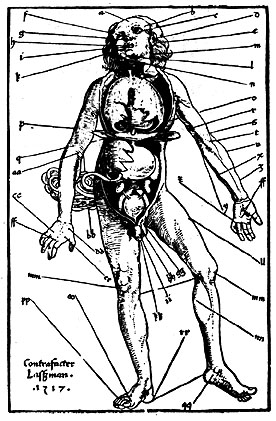Points for blood-letting.
Hans von Gersdorff, "Feldbuch der Wundarznei", 1517.


Blood-letting relieves pain. It also tends to hasten the death of patients who are sometimes already anaemic or in shock. The theoretical basis of blood-letting was the tradition of humoral psychology and physiology dating back to Galen of Pergamon and beyond. But the practice was continued by barber-surgeons and surgeons well into the 19th century.Galen discovered that the veins and arteries are filled with blood, not air as hitherto commonly believed. Unfortunately, Galen had no notion of the circulation of the blood. He believed that blood could "stagnate" in the extremities: it was first created and then used up.
Galen and his successors supposed that the foundation of health and illness lay in humoral balance. The four humours of the body were blood, phlegm, black bile, and yellow bile. These humours were derived from the four classical Greek elements of earth, air, fire and water. Galen believed that we all possess in some degree each of the four humours in an infinite variety of combinations; hence human nature is infinitely diverse, and yet controlled by only four variables.
Since blood was the "dominant" humour, and the influence most in need of control, a physician should aim to restore a healthy balance of his patient's humours by removing "excess" blood (aka plethora), or administer an emetic or diuretic. In Galen's system, the volume of blood to be removed was based on the subject's age, constitution, the season, the weather, physical location, and other subtleties frequently lost on expiring patients.
Throughout history, blood-letting has been used to treat an encyclopaedic array of diseases and kill off innumerable patients who might otherwise have survived. Professor Benjamin Rush, a signatory of the Declaration of Independence and the spokesman of "heroic medicine", viewed the state of his patients' arteries as the key to disease. He advocated "depletive remedies", most notably blood-letting, on an epic scale. His followers opposed the "unnatural" innovation of surgical anaesthesia.